
While you are doing some spring cleaning, be sure to blow the dust off of your striper gear that has been sitting in the garage all winter. If you haven’t done so already, now is the time to do some routine maintenance on your reel, check your guides and organize your tackle as the spring striped bass run in the rivers of Connecticut is upon us.
Usually around late April or early May we see striped bass showing up in force and entering tidal rivers in western Long Island Sound. However, this event may occur even earlier than that depending on how mild the winter was and the current water temperatures. As migrating fish make their way up the coast, they make stops along the way as they chase large baitfish such as herring, shad and bunker. I’ve fished for striped bass in the tidal rivers of Connecticut for over 15 years now and I’m going to share with you some of my top lure choices for this exciting time of year.
Size Matters
Bass stage at the mouth of the tidal rivers and enter the main river hot on the tails of migrating baitfish. Early on when the water is still on the colder side a slower, mid-sized approach is a good idea. Fishing 5- to 7-inch soft plastics close to the bottom is generally the most productive method.
As spring progresses and the run gets hot, fish push into the rivers and I’ve found that matching the hatch is even more important because they’re so very focused on the herring. Sometimes there is so much bait that your offering goes ignored and that is why it’s imperative to present something that looks like the target prey. Lures in the 7- to 9-inch range produce really well by mid-May and continue right on through to the summer as the warming river temperatures force the larger striped bass back out of the river and into the Sound.
Softy Options
In the way of soft plastics, I used to fish a lot of Slug-Gos and super flukes. Dragging and hopping them along the bottom on 1/2- to 3/4-ounce jig heads (depending on the water flow and depth) is an easy enough approach. However, in recent years I’ve taken a strong liking to the Cobra Bait’s Sad Shad. They are more durable than other soft plastics on the market and can withstand the abuse of a long day on the river. They can also be customized by clipping the pre-formed tail to achieve the desired action.
At certain times of the year, color is extremely important and the spring is just such a time. Two of my most productive patterns are the herring (for obvious reasons) both day and night, and solid black for after the sun sets. Eels make up a big part of the ecology of our tidal rivers and they are also a favorite food for striped bass. Fishing black soft plastics close to the bottom is a no brainer to mimic an eel.
Hard Baits Too
An extremely popular choice for spring-run river striped bass in recent years is the Daiwa SP Minnow. This bait performs exceptionally well in the rivers thanks to its great castability combined with its ability to run true at different speeds. Whether it’s slack tide and the river is just moving along or it’s ripping at outgoing/incoming, this bait has been proven time and time again.
When fishing a hard bait, I target boulders and sand bars. The lure is cast out across the current and dead-drifted under tension down across the current making a pass just above the structure. The lure is then popped as it approaches the structure, often enticing a bone-jarring strike as a striped bass lunges out from its hiding spot.

Topwater Excitement
As spring wears on and the water temperature in the rivers increases, topwater lures become more effective on striped bass. The classic straight-bodied poppers catch plenty of fish, as do pencil poppers, but one lure that has served me well over the years is the Heddon Spook. Bass absolutely love that hypnotizing “walk the dog” action and it often draws strikes when other topwater choices go unnoticed. I always have a surplus of these lures on hand in a variety of colors and sizes.
Spooks are effective for a variety of reasons and have a way of selling themselves to a striped bass that often far exceeds other topwater styles. The swaying side-to-side motion is a bit more realistic and natural that other options. Sure, poppers cause a lot of commotion and can trigger aggressive strikes, but baits that actually look real usually get the response we want from bigger, smarter fish. I’ve found that lighter colors in the morning such as yellow or white do well and dark colors like black at night work best. Soft plastics like the aforementioned Sad Shad can also be fished weightless as a less expensive and subtler option for a topwater bait.
So with the mild winter that we’ve had now (hopefully) long behind us, it seems like the run may be on a bit earlier than usual. Herring started showing up in New England back in late February, and action on holdover fish has been pretty good all winter.

| License Requirements |
|---|
|
When targeting striped bass in the tidal rivers of Connecticut, you’ll need to keep track of where the fresh and saltwater demarcation lines are drawn. Unless otherwise noted, the demarcation line is the first bridge upstream from the river mouth or cove. Below these lines and you’ll need a saltwater license, above them a freshwater license. Connecticut also honors RI, MA and NY marine licenses when fishing in saltwater. For a complete listing of the demarcation lines, consult section 26-108-1 of the Regulations of Connecticut State Agencies, and section 26-109 of the Connecticut General Statutes. These can be found at www.ct.gov/deep/laws-regs. Housatonic River: Merritt Parkway bridge, Milford-Stratford. Connecticut River: I-95 bridge, Old Lyme-Old Saybrook. Thames River: 500 feet North of Rte.1, I-95 bridge Groton-New London. |




